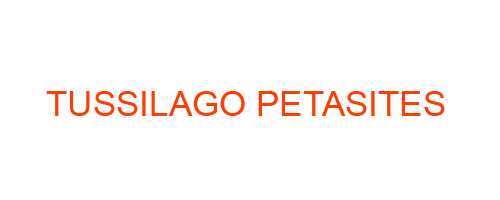Tussilago petasites, commonly known as Butterbur, is a homeopathic medicine derived from the plant Tussilago petasites. It is primarily used for resp
Tussilago petasites, commonly known as Butterbur, is a homeopathic medicine derived from the plant Tussilago petasites. It is primarily used for respiratory conditions, particularly those affecting the bronchial tubes and lungs. Here is some information about Tussilago petasites:
Properties and Preparation:
Tussilago petasites is prepared from the fresh leaves and flowers of the plant.
The plant is harvested during the flowering season and processed into a tincture or dilution according to homeopathic principles.
The resulting remedy is then potentized through a series of dilutions and succussions to enhance its therapeutic properties.
Symptoms and Materia Medica:
Tussilago petasites is known to have an affinity for the respiratory system, especially the bronchial tubes and lungs.
It is indicated in conditions like asthma, bronchitis, and cough, where there is dryness, constriction, and difficulty in breathing.
The remedy also addresses various allergic conditions, including hay fever, sinusitis, and hives.
It may be used for headaches, migraines, vertigo, and fatigue, especially when associated with respiratory or allergic symptoms.
Cough: Persistent, dry cough with tickling sensation in the throat and chest.
Wheezing: Difficulty in breathing accompanied by a whistling sound during exhalation.
Asthma: Constriction of the airways causing shortness of breath, coughing, and wheezing.
Bronchitis: Inflammation of the bronchial tubes, resulting in coughing, mucus production, and chest discomfort.
Hay fever: Allergic reaction to pollen, characterized by sneezing, itchy eyes, and nasal congestion.
Sinusitis: Inflammation of the sinuses causing facial pain, pressure, and nasal congestion.
Headache: Throbbing or dull pain in the head, often associated with sinus congestion.
Migraine: Severe, recurring headaches often accompanied by nausea, vomiting, and sensitivity to light and sound.
Vertigo: Sensation of spinning or dizziness.
Fatigue: Persistent feeling of tiredness and lack of energy.
Allergies: Hypersensitivity reactions to substances such as pollen, dust, or pet dander.
Urticaria (Hives): Raised, itchy skin rash characterized by red or white welts.
Eczema: Inflammatory skin condition causing itchy, red, and scaly patches.
Joint pain: Aching or stiffness in the joints, often associated with inflammation.
Menstrual disorders: Irregular or painful menstrual periods.
FAQ:
Q: Is Tussilago petasites safe to use?
A: When used according to homeopathic principles and under the guidance of a qualified homeopathic practitioner, Tussilago petasites is generally considered safe. However, it is always recommended to consult a healthcare professional before starting any new treatment.
Q: Can Tussilago petasites be used during pregnancy or breastfeeding?
A: It is advisable to consult a healthcare provider before using Tussilago petasites during pregnancy or while breastfeeding.
Q: Are there any known side effects of Tussilago petasites?
A: As a homeopathic remedy, Tussilago petasites is prepared in a highly diluted form, which minimizes the risk of side effects. However, individual sensitivities and reactions may vary, so it is important to monitor your symptoms and consult a professional if any unusual reactions occur.
Books Reference:
“Homeopathy and the Elements: Understanding the Mineral Kingdom” by Jan Scholten
This book provides insights into the mineral kingdom in homeopathy and may offer valuable information about Tussilago petasites as a remedy.
“Desktop Guide to Keynotes and Confirmatory Symptoms” by Roger Morrison
This reference guide includes a section on Tussilago petasites, which can provide detailed information about its key symptoms and indications.
“Materia Medica of New Homeopathic Remedies” by Colin Griffith
This book covers newer remedies in homeopathy, including Tussilago petasites, and provides descriptions of their properties, symptomatology, and clinical indications.
Please note that it’s always a good idea to consult multiple sources and seek guidance from a qualified homeopathic practitioner for accurate information and personalized advice.

